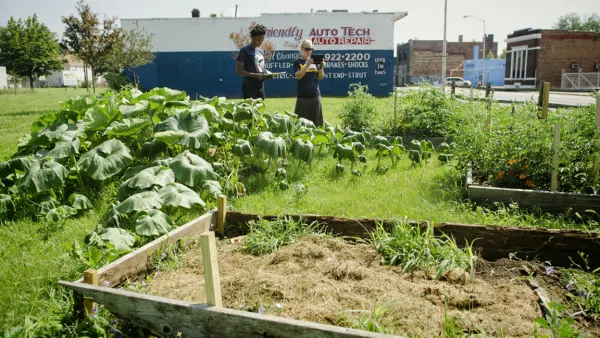This commentary from the Austin American Statesman argues that the city's aim to become the country's most livable city is undercut by its low number of community gardens.
"The laundry list of green initiatives adopted by the City of Austin is a tribute to Austin's commitment to becoming the most livable city in the country. Green oases in the middle of urban areas, community gardens are a necessary part of any livable city. Located in areas easily accessible to residents, these public spaces offer land on which neighbors work together to grow their own food, thereby reducing fuel consumption and pollution emitted by trucking produce across the country."
"Austin is home to 12 community gardens. For a city the size of Austin, this number is well below that of urban areas of similar size. In Portland, Ore., the Parks and Recreation department operates 30 community gardens with assistance from the Friends of Portland Community Gardens. Seattle's Department of Neighborhoods P-Patch Program works with the P-Patch Trust to support the efforts of 54 community gardens."
"Unlike the public programming that supports community gardening in Portland and Seattle, the process for starting a garden in Austin is cumbersome and costly. Though the city does permit groups to use public land for gardens for a nominal annual fee, only five community gardens reside on public property."
FULL STORY: Banks: What's so livable about a city without community gardens?

National Parks Layoffs Will Cause Communities to Lose Billions
Thousands of essential park workers were laid off this week, just before the busy spring break season.

Retro-silient?: America’s First “Eco-burb,” The Woodlands Turns 50
A master-planned community north of Houston offers lessons on green infrastructure and resilient design, but falls short of its founder’s lofty affordability and walkability goals.

Delivering for America Plan Will Downgrade Mail Service in at Least 49.5 Percent of Zip Codes
Republican and Democrat lawmakers criticize the plan for its disproportionate negative impact on rural communities.

Test News Post 1
This is a summary

Test News Headline 46
Test for the image on the front page.

Balancing Bombs and Butterflies: How the National Guard Protects a Rare Species
The National Guard at Fort Indiantown Gap uses GIS technology and land management strategies to balance military training with conservation efforts, ensuring the survival of the rare eastern regal fritillary butterfly.
Urban Design for Planners 1: Software Tools
This six-course series explores essential urban design concepts using open source software and equips planners with the tools they need to participate fully in the urban design process.
Planning for Universal Design
Learn the tools for implementing Universal Design in planning regulations.
EMC Planning Group, Inc.
Planetizen
Planetizen
Mpact (formerly Rail~Volution)
Great Falls Development Authority, Inc.
HUDs Office of Policy Development and Research
NYU Wagner Graduate School of Public Service





























